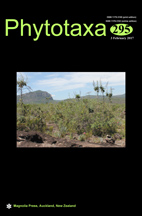Abstract
Carpinus langaoensis Z. Qiang Lu & J. Quan Liu, a new hornbeam species from the Daba Mountains in the Shanxi province of China, is described and illustrated in this study. Morphological comparisons show that this species is similar to C. tientaiensis W. C. Cheng and C. mianningensis Yi, with which it shares the presence of the long bract with lobes at bases of both inner and outer margins and large glabrescent nutlet. However, it is distinct from both in the dense pubescence on the abaxial leaf, and the long infructescence bract. Phylogenetic analyses of ITS sequence variation indicates that these three species form a well-supported monophyletic group, but all examined individuals of the new species are separated from all others by three fixed nucleotide mutations. The new species is also geographically isolated from these two closely related ones. Therefore, all available evidence suggests that a new species (C. langaoensis) should be established for this evolutionarily independent lineage. The new species is known from only a single small population, and so should be treated as a critically endangered species according to the IUCN categories and criteria.

